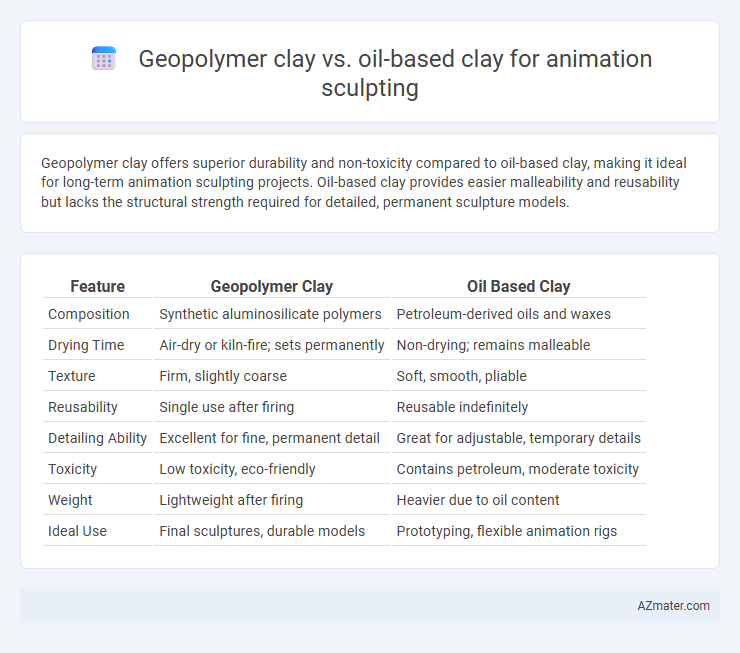Geopolymer clay offers superior durability and non-toxicity compared to oil-based clay, making it ideal for long-term animation sculpting projects. Oil-based clay provides easier malleability and reusability but lacks the structural strength required for detailed, permanent sculpture models.
Table of Comparison
| Feature | Geopolymer Clay | Oil Based Clay |
|---|---|---|
| Composition | Synthetic aluminosilicate polymers | Petroleum-derived oils and waxes |
| Drying Time | Air-dry or kiln-fire; sets permanently | Non-drying; remains malleable |
| Texture | Firm, slightly coarse | Soft, smooth, pliable |
| Reusability | Single use after firing | Reusable indefinitely |
| Detailing Ability | Excellent for fine, permanent detail | Great for adjustable, temporary details |
| Toxicity | Low toxicity, eco-friendly | Contains petroleum, moderate toxicity |
| Weight | Lightweight after firing | Heavier due to oil content |
| Ideal Use | Final sculptures, durable models | Prototyping, flexible animation rigs |
Introduction to Animation Sculpting Materials
Geopolymer clay offers superior durability and fine detail retention for animation sculpting, making it ideal for creating long-lasting prototypes and character models. Oil-based clay remains flexible and reusable, allowing artists to make adjustments without drying out, which is essential during iterative design processes. Both materials serve distinct purposes in animation sculpting, with geopolymer clay favored for permanence and oil-based clay preferred for flexibility and ease of modification.
What is Geopolymer Clay?
Geopolymer clay is an eco-friendly, synthetic material composed mainly of aluminosilicate minerals that hardens through an inorganic polymerization process, offering high durability and heat resistance ideal for animation sculpting. Unlike traditional oil-based clays, geopolymer clay does not remain malleable after sculpting but cures into a solid, making it suitable for creating long-lasting, detailed models. Its non-toxic composition and ability to retain fine textures enhance precision in stop-motion animation and model prototyping.
What is Oil-Based Clay?
Oil-based clay, commonly known as plastilina, is a flexible, non-drying modeling material favored in animation sculpting for its smooth texture and reusability without hardening. Unlike geopolymer clay, oil-based clay maintains its pliability over time, allowing artists to make continuous adjustments during character development and stop-motion animation processes. Its composition, typically a mix of oils, waxes, and clay minerals, prevents drying and cracking, making it ideal for detailed and iterative sculpting workflows.
Key Differences: Geopolymer vs Oil-Based Clay
Geopolymer clay offers superior durability and structural strength compared to oil-based clay, making it ideal for long-term animation sculpting projects requiring detailed and stable models. Unlike oil-based clay, geopolymer clay hardens permanently and withstands high temperatures, allowing for sanding and painting without deformation, whereas oil-based clay remains pliable and is better suited for iterative adjustments and short-term usage. The distinct chemical composition of geopolymer clay, primarily inorganic and ceramic-based, contrasts with the petroleum derivatives in oil-based clay, affecting weight, texture, and environmental resistance in animation workflows.
Workability and Sculpting Techniques
Geopolymer clay offers superior workability with a smooth, pliable texture that mimics natural clay, enabling precise detailing and smooth blending important for animation sculpting. Oil-based clay maintains softness over extended periods, allowing continuous reshaping and fine-tuning without drying, which benefits iterative sculpting techniques and dynamic pose adjustments. Both materials support diverse sculpting tools, but geopolymer clay is often preferred for final hardening and durable animation models, while oil-based clay excels in early-stage sculpting and experimental designs.
Curing and Reusability
Geopolymer clay cures through a chemical reaction at room temperature, resulting in a hard, durable finish ideal for permanent animation sculptures, while oil-based clay remains pliable and does not fully cure, allowing continuous reshaping and reuse. The curing process of geopolymer clay typically takes 24 to 48 hours, producing non-toxic, water-resistant models suitable for long-term display, whereas oil-based clay requires no curing and can be stored indefinitely without drying out. Reusability favors oil-based clay for iterative animation prototyping, while geopolymer clay offers rigidity and permanence when finalized sculptures are needed.
Surface Detail and Texture Quality
Geopolymer clay offers superior surface detail and texture quality for animation sculpting due to its fine grain and smooth consistency, allowing precise sculpting of intricate features. Oil-based clay provides flexibility and ease of reworking but often results in softer textures and less defined details compared to the crisp, hard finish achievable with geopolymer clays. The choice impacts the final animation model's realism, with geopolymer clay favored for high-definition surface textures and prolonged durability during the sculpting process.
Safety and Environmental Considerations
Geopolymer clay for animation sculpting offers a non-toxic, eco-friendly alternative to traditional oil-based clay, reducing exposure to harmful VOCs and petroleum derivatives that pose health risks during prolonged use. Its composition typically includes natural materials like aluminosilicate minerals, which not only minimize environmental impact through biodegradability but also prevent chemical off-gassing common in oil-based clays. The sustainable sourcing and safer handling of geopolymer clay make it preferable for artists prioritizing health-conscious environments and reduced ecological footprints in their creative processes.
Cost Comparison for Animation Projects
Geopolymer clay offers a cost-effective alternative to oil-based clay for animation sculpting, with raw material expenses typically 30-50% lower due to its mineral-based composition and ease of sourcing. Oil-based clay requires frequent replacement and higher storage costs since it never fully cures, increasing overall project expenses significantly. For long-term animation projects, geopolymer clay's durability and reduced waste contribute to substantial savings in material and maintenance budgets.
Choosing the Best Clay for Animation Sculpting
Geopolymer clay for animation sculpting offers superior durability, heat resistance, and a fine detail retention essential for creating precise character models. Oil-based clay remains pliable and reusable, ideal for iterative sculpting but lacks the hardening properties required for permanent displays or stop-motion filmmaking. Choosing the best clay depends on project needs: use geopolymer clay for stable, detailed prototypes and oil-based clay for flexible, ongoing sculpting processes.

Infographic: Geopolymer clay vs Oil based clay for Animation sculpting
 azmater.com
azmater.com